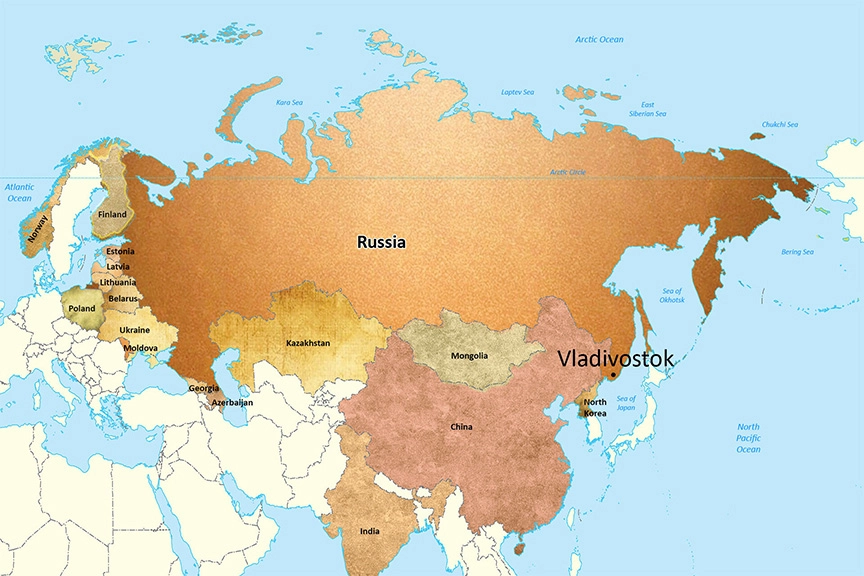International Relations
Eastern Economic Forum
- 17 Sep 2022
- 7 min read
For Prelims: Significance of Russia’s Far East, IPEF, China’s RCEP.
For Mains: Eastern Economic Forum and India’s Balancing Act.
Why in News?
Recently, Russia hosted the 7th Eastern Economic Forum (EEF) at Vladivostok.
- The forum is a platform for entrepreneurs to expand their businesses into Russia’s Far East (RFE).
What is the Eastern Economic Forum?
- About:
- The EEF was established in 2015 to encourage foreign investments in the RFE.
- The EEF displays the economic potential, suitable business conditions and investment opportunities in the region.
- Agreements signed at the EEF increased from 217 in 2017 to 380 agreements in 2021, worth 3.6 trillion roubles.
- The agreements focus on infrastructure, transportation projects, mineral excavations, construction, industry and agriculture.
- Key Players:
- China, South Korea, Japan and India are the Key Players in the region, where China is the biggest investor.
- China who sees potential in promoting the Chinese Belt and Road Initiative (BRI) and the Polar Sea Route in the RFE.
- China’s investments in the region account for 90% of the total investments.
- China, South Korea, Japan and India are the Key Players in the region, where China is the biggest investor.
- Objectives:
- Russia has strategically developed the region with the aim of connecting Russia to the Asian trading routes.
- With the fast modernisation of cities like Vladivostok, Khabarovsk, Ulan-Ude, Chita and more, Russia aims to attract more investments in the region.
- To survive the economic crisis and the sanctions with the help of China and other Asian powers.
What is the Significance of the RFE?
- The region encompasses one-third of Russia’s territory and is rich with natural resources such as fish, oil, natural gas, wood, diamonds and other minerals.
- The small population living in the region is another factor for encouraging people to move and work in the Far East.
- The region’s riches and resources contribute to 5 % of Russia’s GDP (Gross Domestic Product).
- But despite the abundance and availability of materials, procuring and supplying them is an issue due to the unavailability of personnel.
- The RFE is geographically placed at a strategic location, acting as a gateway into Asia.
What does India Seek at the Forum?
- India seeks to expand its influence in the RFE. During the forum, India expressed its readiness in expanding trade, connectivity and investments in Russia.
- India is keen to deepen its cooperation in energy, pharmaceuticals, maritime connectivity, healthcare, tourism, the diamond industry and the Arctic.
- In 2019, India offered a USD 1 billion line of credit to develop infrastructure in the region.
- Through the EEF, India aims to establish a strong inter-state interaction with Russia.
- Business representatives of Gujarat and the Republic of Sakha (Russia) have launched agreements in the diamond and pharmaceuticals industry.
How does India act at Balancing Between the EEF and IPEF?
- Since the coming together of countries like Myanmar, Armenia, Russia, and China for EEF seems like the forming of an Anti-Sanctions Group in the international order, India has vested interests in both the forums, EEF and IPEF (U.S.-led Indo-Pacific Economic Framework).
- India has not shied away from investing in the Russia-initiated EEF despite the current international conditions, where western countries impose Sanctions on Russia.
- At the same time, India has given its confirmation and acceptance to three of the four pillars in the IPEF.
- India understands the benefits of being involved in the development of the RFE but it also perceives the IPEF as a vital platform to strengthen its presence in the Indo-Pacific region.
- The IPEF also presents an ideal opportunity for India to act in the region, without being part of the China-led Regional Comprehensive Economic Partnership or other regional groupings like the Comprehensive and Progressive Agreement for Trans-Pacific Partnership.
UPSC Civil Services Examination, Previous Year Question (PYQ)
Prelims
Q. India is a member of which among the following? (2015)
- Asia-Pacific Economic Cooperation
- Association of South-East Asian Nations
- East Asia Summit
Select the correct answer using the code given below:
(a) 1 and 2 only
(b) 3 only
(c) 1, 2 and 3
(d) India is a member of none of them
Ans: (b)
Exp:
- Established in 1989, Asia-Pacific Economic Cooperation (APEC) cites minimum eligibility that countries must share borders with the Pacific Ocean to be a member. India is not a member and was invited to be an observer for the first time in November 2011. It is a 21-member body. Hence, 1 is not correct.
- Established in 1961, Association of Southeast Asian Nations (ASEAN) is a regional intergovernmental organization comprising ten countries in Southeast Asia, which promotes intergovernmental cooperation and facilitates economic, political, security, military, educational, and socio-cultural integration among its members and other countries in Asia. India is located in South Asia and is not a member of ASEAN. Hence, 2 is not correct.
- Established in 2005, the East Asia Summit (EAS) is an 18 member States body for strategic dialogue and cooperation on the key political, security, and economic challenges facing the Indo-Pacific region. It comprises the Association of Southeast Asian Nations (ASEAN) member states along with 8 members-Australia, China, Japan, India, New Zealand, the Republic of Korea, Russia and the United States. Hence, 3 is correct.
- Therefore, option (b) is the correct answer.
Mains
Q. What is the significance of Indo-US defence deals over Indo-Russian defence deals? Discuss with reference to stability in the Indo-Pacific region. (2020)





